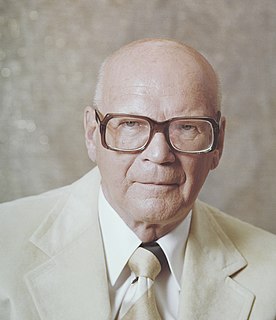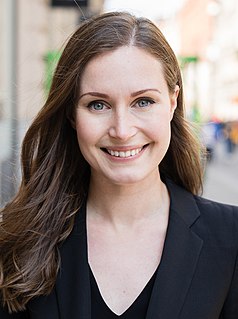
Urho Kaleva Kekkonen, often referred to by his initials UKK, was a Finnish politician who served as the eighth and longest-serving president of Finland from 1956 until 1982. He was the third and most recent president from the Agrarian League/Centre Party. As head of state for nearly 26 years, he dominated Finnish politics, held a large amount of power, won his later elections with little opposition and has often been classified as an autocrat. Nevertheless, he remains a respected figure.
The Swedish People's Party of Finland is a political party in Finland aiming to represent the interests of the minority Swedish-speaking population of Finland. The party is currently participating in the government of Sanna Marin, holding the positions of Minister of Justice and Minister for Nordic Cooperation and Equality.

The prime minister of Finland is the head of the Finnish Government. The prime minister is Finland's head of government and is formally ranked third in the protocol after the president of Finland and the speaker of the Parliament. Finland's first prime minister was Pehr Evind Svinhufvud, was appointed on 27 November 1917, just a few days before the country became independent.
A minister without portfolio is either a government minister with no specific responsibilities or a minister who does not head a particular ministry. The sinecure is particularly common in countries ruled by coalition governments and a cabinet with decision-making authority wherein a minister without portfolio, while they may not head any particular office or ministry, may still receive a ministerial salary and has the right to cast a vote in cabinet decisions. In some countries where the executive branch is not composed of a coalition of parties and, more often, in countries with purely presidential systems of government, such as the United States, the position of minister without portfolio is uncommon.

Karl-August Fagerholm was Speaker of Parliament and three times Prime Minister of Finland. Fagerholm became one of the leading politicians of the Social Democrats after the armistice in the Continuation War. As a Scandinavia-oriented Swedish-speaking Finn, he was believed to be more to the taste of the Soviet Union's leadership than his predecessor, Väinö Tanner. Fagerholm's postwar career was, however, marked by fierce opposition from both the Soviet Union and the Communist Party of Finland. He narrowly lost the presidential election to Urho Kekkonen in 1956.
Parliamentary elections were held in Finland on 6 and 7 July 1958. The communist Finnish People's Democratic League emerged as the largest party, but was unable to form a government.
Parliamentary elections were held in Finland on 1 and 2 July 1948.
Tammi, also known as Kustannusyhtiö Tammi and Tammi Publishers, is a Finnish publishing company established in 1943 by an initiative of Väinö Tanner, leader of the Social Democratic Party of Finland. In 1996, the company was bought by the Bonnier Group, and, as of the early 2000s, it was the third largest book publisher in Finland. In 2018, the company was merged into the Finnish book publishing company Werner Söderström Osakeyhtiö (WSOY). Tammi was formerly known as Kustannusosakeyhtiö Tammi.

Monika Kristina Fagerholm is a Swedish-speaking Finnish author living in Ekenäs, Finland. She is the daughter of professor Nils-Erik Fagerholm and library amanuensis Kristina Herrgård. Fagerholm has studied psychology and literature at the University of Helsinki. In 1987, she received her bachelor's degree in psychology and literature. Fagerholm made her debut in 1987 with Sham but her real breakthrough in the literary scene was in 1994 with Underbara kvinnor vid vatten. The book was nominated for the Finlandia Prize, which is the biggest literary prize in Finland. It was also nominated for the August prize in 1995, in Sweden and also the International Dublin Literary Award in 1998. In 1994, she received the Runeberg Award in Finland. The movie adaptation of the novel by Claes Olsson premiered in 1998. Fagerholm received the August prize in 2005 for Den amerikanska flickan.
Karl-August Fagerholm's second cabinet was the 40th government of Republic of Finland. Cabinet's time period was from March 3, 1956 to May 27, 1957. It was Majority government.
Karl-August Fagerholm's third cabinet was the 44th government of Republic of Finland. Cabinet's time period was from September 29, 1958 to January 13, 1959. It was Majority government.

Yrjö Kaarlo Leino was a Finnish communist politician. Imprisoned twice for his communist activities, and spending much of the Second World War as an underground communist activist, he served as a minister in three cabinets between 1944 and 1948.

Valdemar (Vladimir) Liljeström was a Finnish trade union activist and politician. He was at first a member of the Social Democratic Party of Finland and, after 1959, of the Social Democratic Union of Workers and Smallholders. He served as the chairman of the Metalworkers' Union from 1947 until 1960, as Minister of Social Affairs in Karl-August Fagerholm's first cabinet, Deputy Minister of Public Works in Vieno Johannes Sukselainen's first cabinet, Minister of Social Affairs in Reino Kuuskoski's cabinet and as a Member of Parliament.

The Social Democratic Party of Finland, shortened to the Social Democrats and commonly known in Finnish as Demarit, is a social-democratic political party in Finland. It is currently the largest party in the Parliament of Finland with 40 seats.

Two-stage presidential elections were held in Finland in 1956. On 16 and 17 January the public elected presidential electors to an electoral college. They in turn elected the President. The result was a victory for Urho Kekkonen, who won on the third ballot over Karl-August Fagerholm. The turnout for the popular vote was 73.4%. Kekkonen had been Juho Kusti Paasikivi's heir apparent since the early 1950s, given his notable political skills for building coalitions, bargaining, risk-taking and adjusting his tactics, actions and rhetoric with regard for the prevailing political wind. On the other hand, his behaviour and political tactics, including sharp-tongued speeches and writings, utilization of political opponents' weaknesses, and rather close relations with the Soviet leaders, were severely criticized by several of his political opponents. Kekkonen's colourful private life, including occasional heavy drinking and at least one extramarital affair, also provided his fierce opponents with verbal and political weapons to attack him. Several other presidential candidates were also criticized for personal issues or failures. Despite all the anti-Kekkonen criticism, his political party, the Agrarians, succeeded for the first time in getting the same share of the vote in the presidential elections' direct stage as in the parliamentary elections. President Paasikivi had neither publicly agreed nor refused to be a presidential candidate. He considered himself morally obliged to serve as President for a couple of more years, if many politicians urged him to do so. Between the first and second ballots of the Electoral College, one National Coalitioner phoned him, asking him to become a dark-horse presidential candidate of the National Coalitioners, Swedish People's Party and People's Party (liberals). At first, Paasikivi declined, requiring the support of Social Democrats and most Agrarians. Then he moderated his position, but mistakenly believed that he would receive enough Social Democratic, Agrarian and Communist and People's Democratic electors' votes to advance to the crucial third ballot. This did not happen, because all Agrarian electors remained loyal to Kekkonen, all Social Democratic electors remained loyal to Fagerholm, and the Communist and People's Democratic electors split their votes to help Fagerholm and Kekkonen advance to the third ballot. The bitterly annoyed and disappointed President Paasikivi publicly denied his last-minute presidential candidacy two days later. Kekkonen was elected President with the narrowest possible majority, 151 votes to 149. For several decades, the question of who cast the decisive vote for him has been debated among Finnish politicians and some Finnish journalists.

The 1949 Kemi strike was a strike in July–August 1949 by the workers of Kemi Oy in the Northern Finnish town of Kemi. On August 18 the strike escalated on a violent clash called "Kemi Bloody Thursday" between strikers and local police, two workers were killed and several injured. Kemi strike is so far the last fatal political protest in Finland.
Kalle Jalmari Kauhanen was a Finnish bricklayer and politician. He was in prison for political reasons from 1931 to 1934. He was subsequently elected to the Parliament of Finland, where he represented the Finnish People's Democratic League (SKDL) from 1945 to 1949 and the Social Democratic Party of Finland (SDP) from 1949 to 1951 and again from 1954 to 1958. Kauhanen was originally a member of the Communist Party of Finland (SKP), but after he refused in October 1948 to join in a motion of no confidence presented by the SKDL parliamentary group to the Social Democratic cabinet led by Karl-August Fagerholm, he was accused of titoism and excluded from the SKP, after which he joined the Social Democratic Party.

Tyyne Lilja Leivo-Larsson was a Finnish Ambassador and MP. She was the first Finnish woman to serve as Ambassador in Oslo from 1958 to 1966 and as Envoy to Reykjavík in 1958–1964 and the first Nordic woman, who led the government when she served as Deputy Prime Minister for Reino Kuuskoski in 1958.

The Night Frost Crisis or the Night Frost was a political crisis that occurred in Soviet-Finnish relations in the autumn of 1958. It arose from Soviet dissatisfaction with Finnish domestic policy and in particular with the composition of the third government to be formed under Prime Minister Karl-August Fagerholm. As a result of the crisis, the Soviet Union withdrew its ambassador from Helsinki and put pressure on the Finnish government to resign. The crisis was given its name by Nikita Khrushchev, who declared that relations between the countries had become subject to a "night frost".

Vieno Simonen was a Finnish politician and farmer. A member of the Agrarian League, she represented Kuopio East in the Parliament of Finland from 1948 to 1962. After serving in deputy ministerial positions in the Kekkonen IV, Törngren, and Fagerholm II cabinets, she was twice appointed as minister of social affairs by prime ministers V. J. Sukselainen and Martti Miettunen, and held the position from 1959 to 1962.












